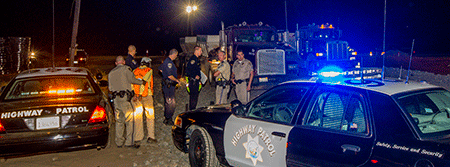SEJournal Online is the digital news magazine of the Society of Environmental Journalists. Learn more about SEJournal Online, including submission, subscription and advertising information.

After arresting a news photographer in an apparent attempt to suppress news by intimidation, the California Highway Patrol (CHP) has changed its policies. But the state may still not "get it" when it comes to media access.
The CHP arrested Steven Eberhard, a freelance photographer for the Willits News, on July 23, 2013, as he tried to photograph a protest against highway bypass construction in the Northern California town.
The Society of Environmental Journalists complained in an August 7 letter to CHP that the arrest was a violation of constitutionally guaranteed freedom of the press. CHP responded August 28, noting that its policies for news media access to the Willits site had changed.
Eberhard spent about 2-1/2 hours in police custody while being booked. But Mendocino County District Attorney Dave Eyster thought so little of the arrest's merits that he never filed charges.
Before Eberhard's arrest, the CHP had told protesters that when a journalist shows up at a protest, the first one arrested would be the media, according to the Woodland Daily Democrat.
CalTrans, the agency constructing the bypass, has required journalists to have a CalTrans escort when entering the site. But escorts had been unavailable during the off-hours when protests often occurred. Eberhard had called for an escort the day of his arrest, but got none. Under a new policy, journalists can call the CHP dispatcher to get access if a CalTrans escort is unavailable.
But in its response letter to SEJ, CHP made several assertions that are not true, according to Eberhard and a video of the incident. Eberhard did not enter the site as part of the protest contingent, as CHP asserts. He was not given a formal order to leave, as CHP asserts. He was not given adequate time to leave, as CHP asserts (about 40 seconds elapsed between the time Eberhard approached one officer with a handshake and the time another officer began handcuffing him). Eberhard did not refuse to leave, as the CHP asserts, but told the officers he would leave.
After reading CHP's account of the incident in its letter to SEJ, Eberhard called various parts of it "bullshit," "fabrication," "bogus," and "just not true at all." He said he was "surprised" that CHP Northern Division Chief B.T. Lott, who signed the response to SEJ, had backed up the story of the arresting officers "when they are lying to her."
In its letter, the CHP said part of its mission was to ensure the safety of the news media — and noted a new policy requiring media to wear hard hats and safety vests. But Eberhard noted that CalTrans had previously decreed a policy forbidding media to wear hard hats and safety vests — on the grounds that it could cause them to be mistaken for construction workers.
Eberhard continues to cover the bypass construction and protests for the Willits news — extensively. He did a series of aerial photos of the site published September 7.
But it remains unclear whether California's state government is really committed to media access to news events.
Eberhard reports that CHP's new protocol for access to the site prevented him from getting much access as he tried to cover a protest incident the night of September 10.
And a state agency blocked news media access to another "public" event on September 2, 2013. It was a public input session on the construction of tunnels as part of the Bay Delta Conservation Plan (BDCP). When Central Valley Business Times reporter Gene Beley showed up at the Brentwood Public Library meeting room and started talking to members of the public, Department of Water Resources staff told him press were not allowed. He did not leave. As if to demonstrate how little "public" California wants in "public affairs," Nancy Vogel, a PAO from the Department of Water Resources (DWR), even called Doug Caldwell, owner of Central Valley Business Times, and complained that Beley was actually reporting on the public's input.
- California Highway Patrol response letter of August 28, 2013, to SEJ.
- Editorial: "David Little: CHP Makes a Protest Worse," Chico Enterprise-Record, August 4, 2013, by David Little.
- Previous Stories: SEJ WatchDogs of August 14, 2013 and July 31, 2013.
- "Brown Administration Bars Reporter from Public Meeting on Tunnels," Daily Kos, September 7, 2013, by Dan Bacher.












 Advertisement
Advertisement 



